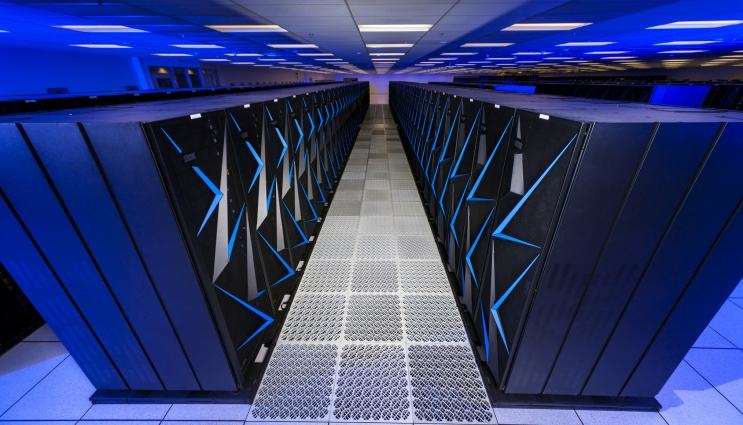Lab stands tall on bi-annual list of Top500 supercomputers
 (Download Image)
(Download Image)
Sierra was one of six Lawrence Livermore National Laboratory supercomputers to make the latest TOP500 List of the most-powerful supercomputers in the world. Sierra held on to the No. 3 spot, achieving 94.6 petaFLOPs on the High Performance LINPACK (HPL) benchmark. LLNL’s presence was bolstered by the addition of Ruby, a recently announced computing cluster that hit 3.7 petaFLOPs on the HPL, ranking it No. 79 in the world. Photo by Randy Wong/LLNL
Lawrence Livermore National Laboratory (LLNL) can lay claim to housing four of the world’s 100 most powerful supercomputers, more than any other institution according to the TOP500 List announced Monday during the virtual Supercomputing 2020 conference (SC20).
The 125-petaFLOP peak Sierra, the National Nuclear Security Administration’s flagship supercomputer, remained third in the world, achieving 94.6 petaFLOPs (floating operations per second) on the High Performance LINPACK (HPL) benchmark. The LINPACK reflects the performance of a dedicated system for solving a dense system of linear equations and is used to determine the Top500.
Sierra ranked behind the reigning No. 1, Japan’s Fugaku supercomputer — which upped its HPL performance to 442 petaFLOPs from June’s TOP500 list — and Oak Ridge National Laboratory’s IBM/NVIDIA powerhouse Summit, which remained the fastest system in the United States at 148.8 petaFLOPs. Sierra also was 15th on the Green500 List of the world’s most energy-efficient supercomputers.
Lassen, which has the same architecture as Sierra but is about one-third of Sierra’s size, dropped to 17th on the list at 18.2 petaFLOPs. Lassen performs unclassified work for NNSA’s Advanced Simulation and Computing (ASC) program, “cognitive simulation”-based modeling for inertial confinement fusion experiments and cancer and COVID-19 drug discovery.
LLNL’s presence on the TOP500 was bolstered by the arrival of Ruby, a recently announced Intel/Supermicro cluster used for programmatic work in support of NNSA’s stockpile stewardship mission, LLNL open science and COVID-19 research. Ruby hit 3.7 petaFLOPs on the HPL, ranking it No. 79 in the world. Ruby was funded by the NNSA ASC program, LLNL’s Multi-programmatic and Institutional Computing program and the Coronavirus Aid, Relief and Economic Security Act.
The Penguin/Intel cluster Magma, an NNSA Commodity Technology System (CTS-1) that performs mission simulations critical to ensuring the safety, security and reliability of the nation’s nuclear weapons in the absence of underground testing, squeezed into the Top 100 at No. 94, scoring 3.24 petaFLOPS on the HPL.
“The number of systems that LLNL has in the Top 100 is not only reflective of the demand for cycles that our stockpile stewardship mission and other important national security work requires but is also indicative of the diversity in system architectures needed to meet all those various objectives,” said Chris Clouse, acting director of LLNL’s ASC program.
With the addition of Ruby, LLNL has a total of six machines on the TOP500 List, also tops among supercomputing centers. The other systems making the list were the Penguin/Intel CTS-1 commodity clusters Jade and Quartz, at 134 and 135 respectively.
TOP500 representatives said the 56th edition of the twice-yearly list reflects a flattening performance growth curve, as it recorded the least number of new entries since the project began in 1993. Two new systems did crack the Top 10: Germany’s JUWELS Booster Module, which debuted at seventh, and Saudi Arabia’s Dammam-7, which ranked 10th.
The TOP500 list is compiled by Erich Strohmaier and Horst Simon of Lawrence Berkeley National Laboratory; Jack Dongarra of the University of Tennessee, Knoxville; and Martin Meuer of ISC Group, Germany.
See more information and to view the entire Top500 List.
Contact
 Jeremy Thomas
Jeremy Thomas
[email protected]
(925) 422-5539
Related Links
Top500 ListSierra
Tags
ASCHPC, Simulation, and Data Science
Computing
Featured Articles







